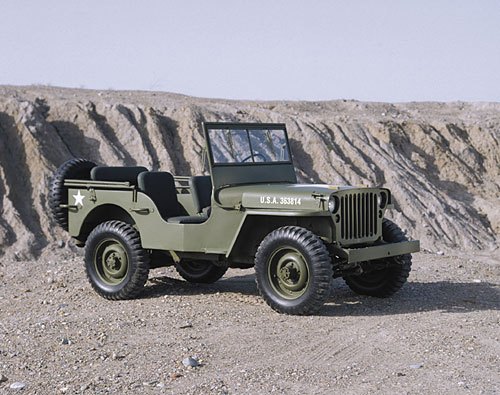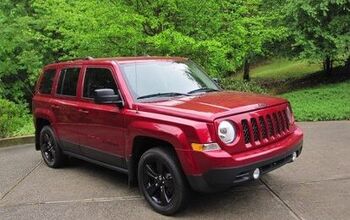In Defense of . . . The Jeep Jinx
I’m a Jeep owner, a Jeep historian and a Jeep enthusiast. I’ve published more than a dozen Jeep articles. I’ve attended dozens of Jeep Jamborees and Camp Jeep events. I’ve driven a Jeep down the Rubicon Trail from start to finish, twice. So it pains me to write about the Jeep Jinx. But the facts are inarguable: virtually every company that’s owned the Jeep brand has fallen on hard times.
The original Jeep prototype was designed and built by a small company called American Bantam. The vehicle’s tendency to be both a curse and a blessing was assured from the start; the U.S. military liked it so much it they shoved Bantam aside. They commissioned competitors Willys-Overland and Ford to more or less copy the design.
In terms of perfecting the vehicle (including better torque), Willys-Overland did most of the heavy lifting. Not surprisingly, the feds gave Ford the nod for organizing mass production. Working together, the two automakers built some 600,000 examples.
After World War II, Ford got out of the Jeep-building business. Willys Motors produced the first civilian Jeep, the CJ-2A, on July 17, 1945. After a slow start (1824 units), sales of the farm-friendly vehicle took off. Willys manufactured the Jeep CJ-2A until 1949, racking up 214,202 sales.
The automaker replaced it with the CJ-3A. But agricultural sales dried up, as farmers turned to tractors. It was not the first time—nor the last–that Jeep found a market pulled out from under its feet, putting its corporate owners in financial jeopardy.
By 1953, Willys-Overland was struggling for survival. The ailing Kaiser-Frazer Corporation decided to buy Willys-Overland, ditch its own car business and produce Jeeps. The reconstituted Willys Motors, Incorporated was born.
In 1963, Willys became Kaiser-Jeep. Looking for new civilian markets, the company introduced the Wagoneer, the precursor to the modern SUV. While the recreational vehicle marketplace experienced sustained growth throughout the sixties, Kaiser-Jeep continued to lose money.
In 1970, American Motors (AMC)—who had its own bout with bankruptcy in 1967—purchased Kaiser’s Jeep operations. In spite of two oil crunches in the seventies, Jeep experienced rapid growth under AMC’s management. The market for dual-purpose vehicles expanded dramatically.
Unfortunately, AMC’s car-making operations were not competitive. Renault partnered with the troubled automaker, then seized control. As the eighties progressed, Renault fell on hard times. Sales of Renault-engineered small cars failed in the US market. The state-owned company also faced political difficulties in its home market.
Renault soon sold its stake in AMC to Chrysler, whose charismatic CEO Lee Iacocca coveted the Jeep brand. In 1987, AMC “merged” with Chrysler. In reality, Jeep was absorbed by Chrysler. This was no bad thing. Chrysler experienced one of the most-sustained growth periods in its history. The rising tide lifted all Jeeps.
This growth period was highly profitable for Chrysler, and Jeep. In 1992, Chrysler debuted the hugely successful Grand Cherokee, an AMC design. The American automaker’s success made it an attractive acquisition target for Daimler, who saw expansion as a way to avoid an unfriendly takeover. At the same time, Chrysler’s executives considered it an opportune time to “cash in their chips.”
And thus the now notorious “merger of equals” with Germany’s Daimler-Benz in 1998, forming DaimlerChrysler. DaimlerChrysler eventually sold most of its interest in Chrysler to Cerberus in 2007—even as Jeep produced some of the least worthy vehicles to ever wear the famous badge.
Two years later, Cerberus lost the rest of its stake as Chrysler descended into C11. With the fed’s help, Italy’s Fiat is pickng-up the pieces. To recap . . .
– Willys – Defunct, sold Jeep to Kaiser in 1953
Jeep is one of the world’s best-known brands. It was one of the pioneers of the sport utility category. Over the years, especially under Chrysler’s stewardship, Jeep sold millions of vehicles. The Wrangler is a worldwide icon. Until recently, the Grand Cherokee was a best-selling SUV, that sold 300,000 units annually.
But it core strength—go-anywhere capability—has always been its weakness. In other words, whether serving the military, farm owners, off-road enthusiasts or Soccer Moms, Jeep is a niche brand. As recent history has shown (e.g., Aston Martin, Jaguar, Land Rover, Saab, HUMMER, Volvo, etc.), large companies and niche brands make terrible bedfellows. Big companies seek volume above all; a tendency that tends to kill the goose that lays the golden eggs.
In fact, you could say that Jeep’s owners have been a jinx on Jeep. With Fiat eyeing Jeep as a way to help it grow to the size it thinks it needs to survive, one gets the distinct impression that bad things are about to happen. Again. Will Fiat be the company that ultimately breaks the Jeep Jinx?
[Read more of Rich Truedell’s work at automotivetraveler.com]
More by Rich Truesdell
Latest Car Reviews
Read moreLatest Product Reviews
Read moreRecent Comments
- Bd2 Would be sweet on a Telluride.
- Luke42 When will they release a Gladiator 4xe?I don’t care what color it is, but I do care about being able to plug it in.
- Bd2 As I have posited here numerous times; the Hyundai Pony Coupe of 1974 was the most influential sports and, later on, supercar template. This Toyota is a prime example of Hyundai's primal influence upon the design industry. Just look at the years, 1976 > 1974, so the numbers bear Hyundai out and this Toyota is the copy.
- MaintenanceCosts Two of my four cars currently have tires that have remaining tread life but 2017 date codes. Time for a tire-stravaganza pretty soon.
- Lorenzo I'd actually buy another Ford, if they'd bring back the butternut-squash color. Well, they actually called it sea foam green, but some cars had more green than others, and my 1968 Mercury Montego MX was one of the more-yellow, less-green models. The police always wrote 'yellow' on the ticket.







































Comments
Join the conversation
Hotchkiss of France (Of machine gun fame, and founded by an American) also produced Jeeps, and is now defunct, have been absorbed/merged by other firms. On the other hand, Mahindra and Mihindra of India also produced Jeeps under license, and as far as I know is still making Jeep like vehicles (sans license I believe) and doing fairly well. Edit - Slow_Joe_Crow : You beat me to it while I was typing.
I checked out the "$25 Jeep" rumors in the 70s. It was semi-true. More like $100 on up, but only in lots of 500 or more, if I remember correctly. And no guarantees that they ran or were even complete.